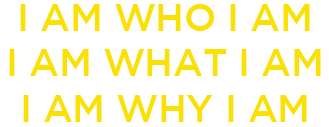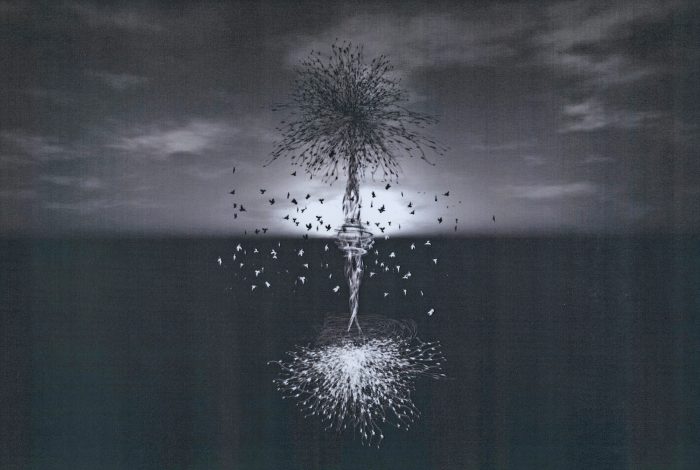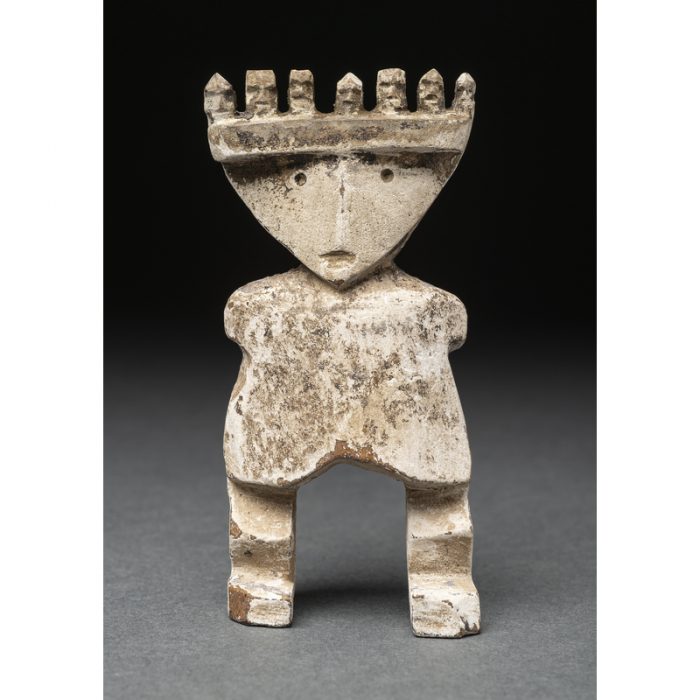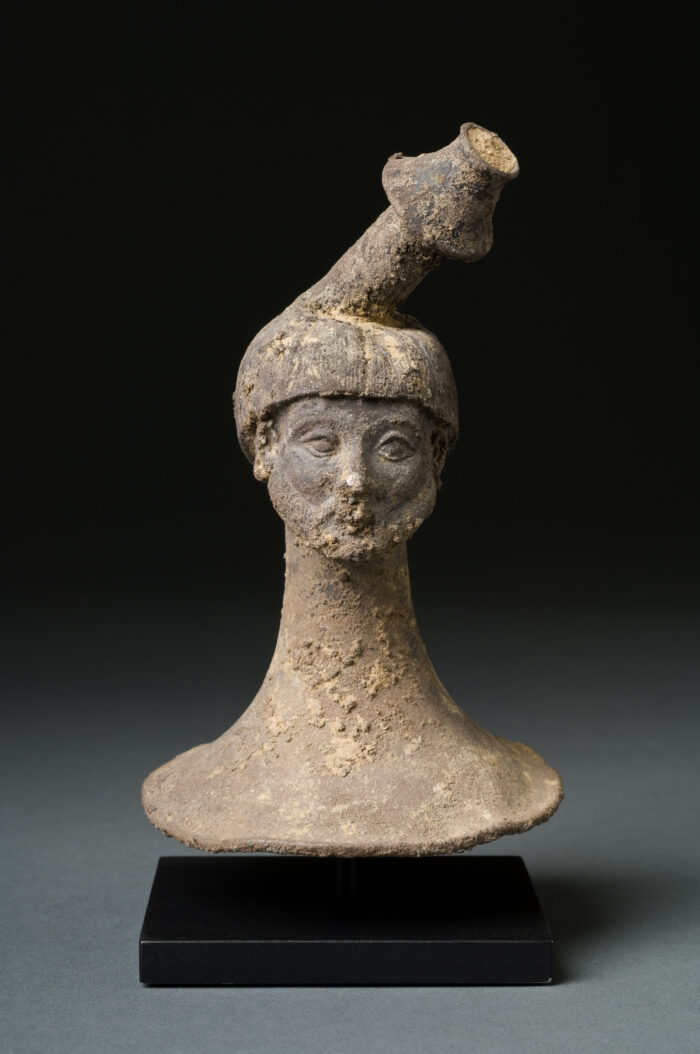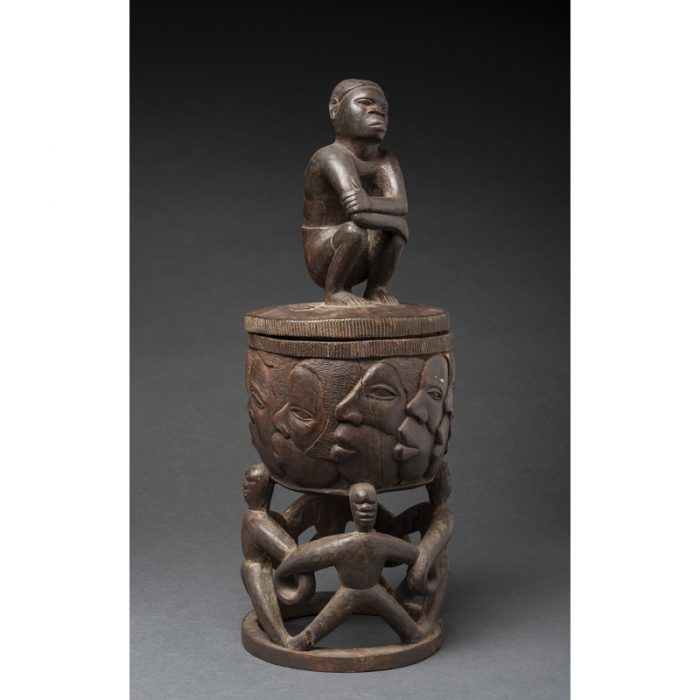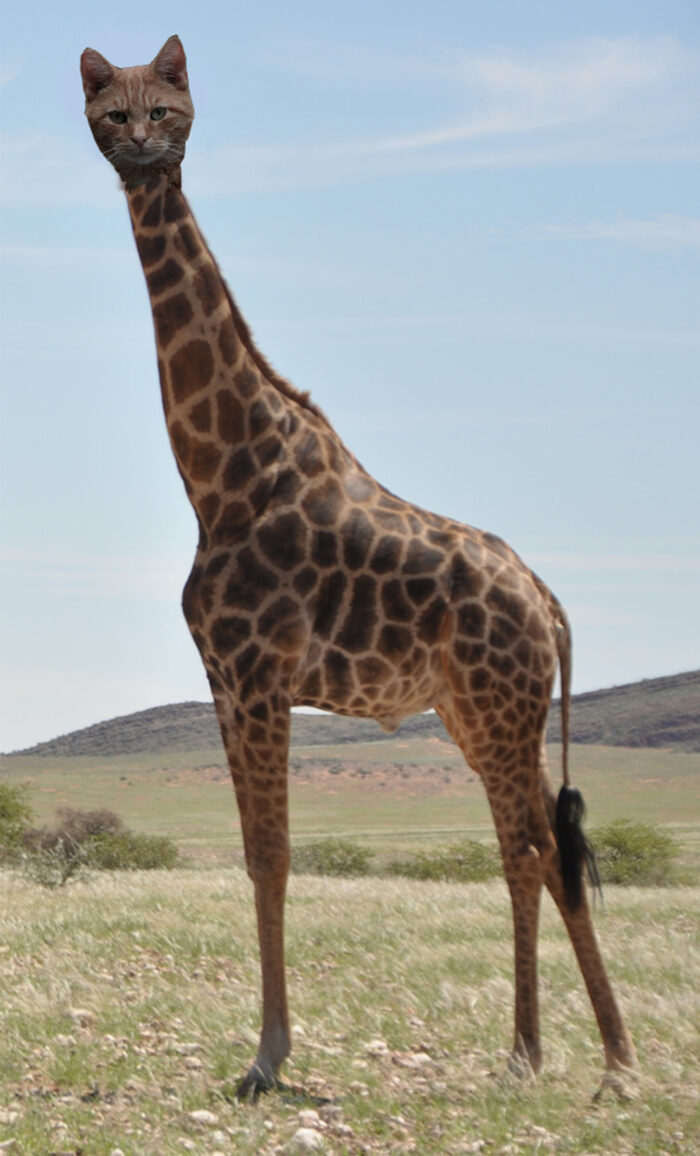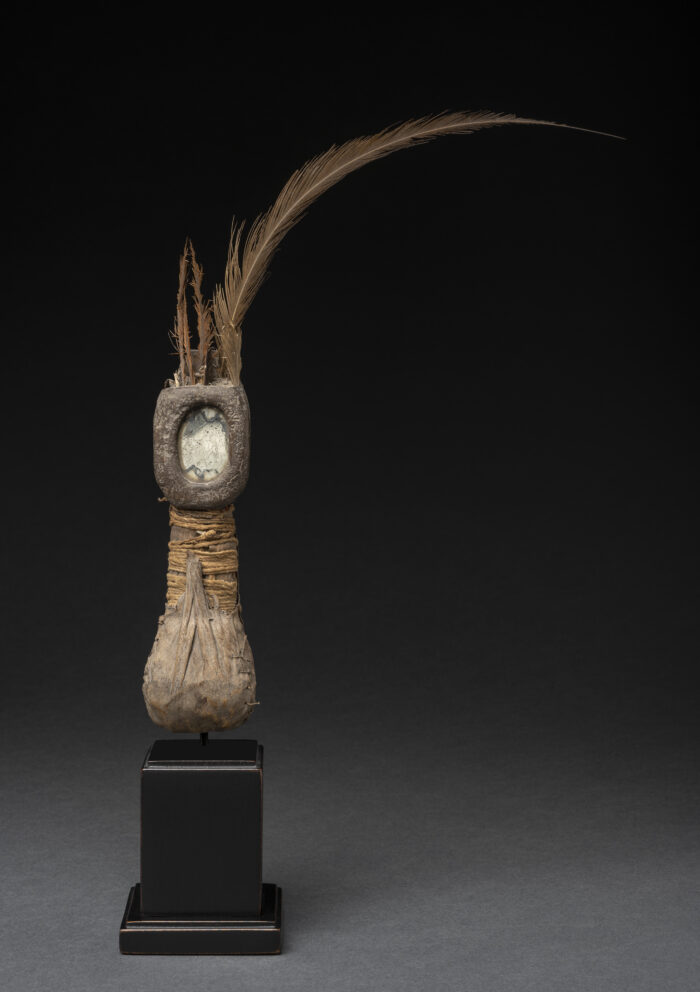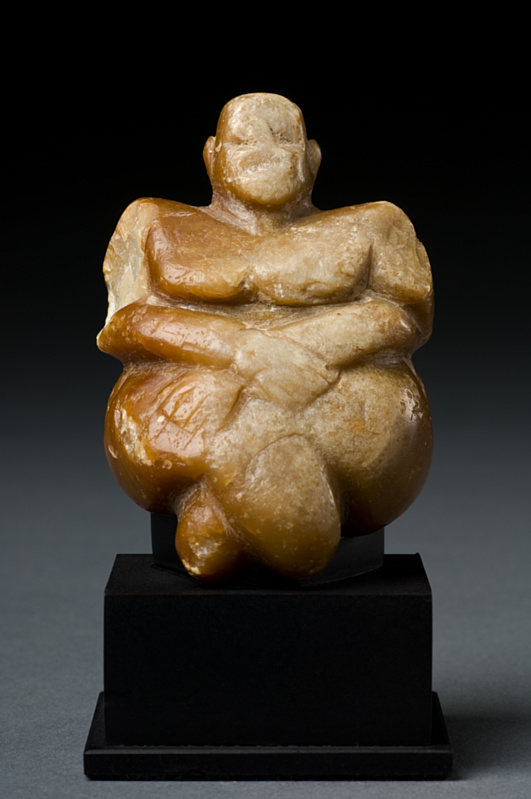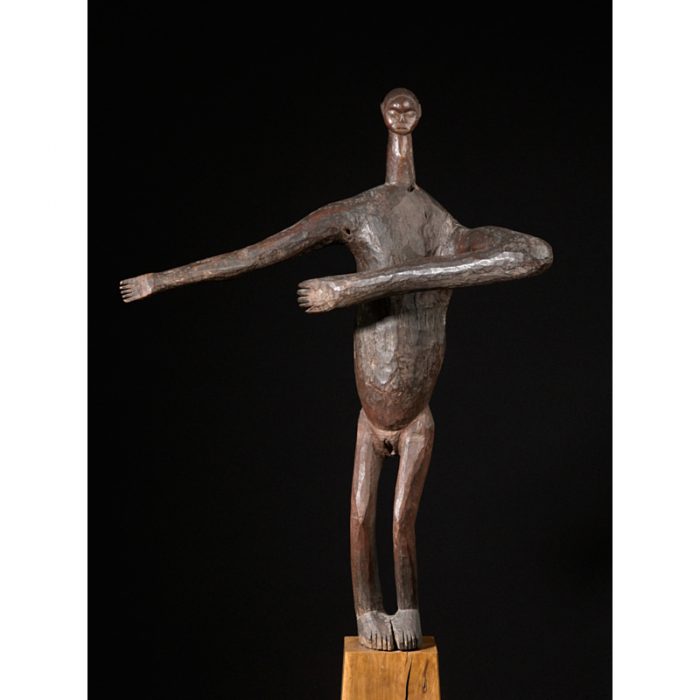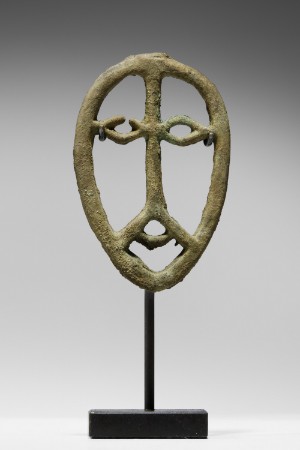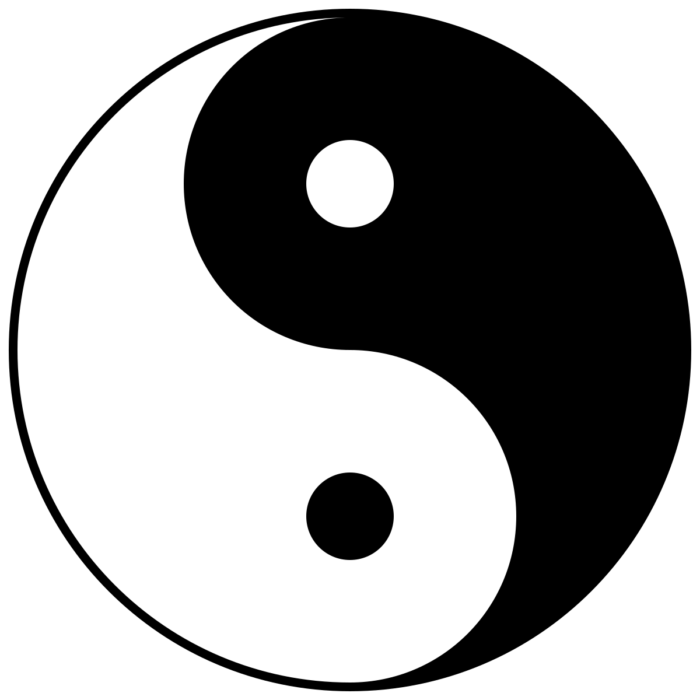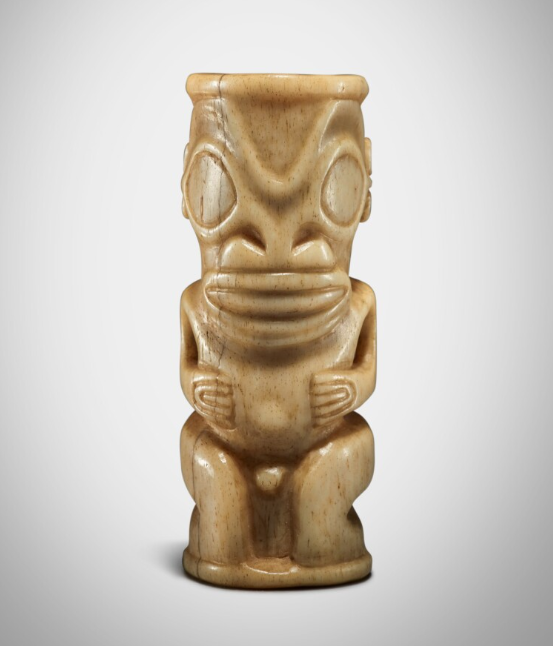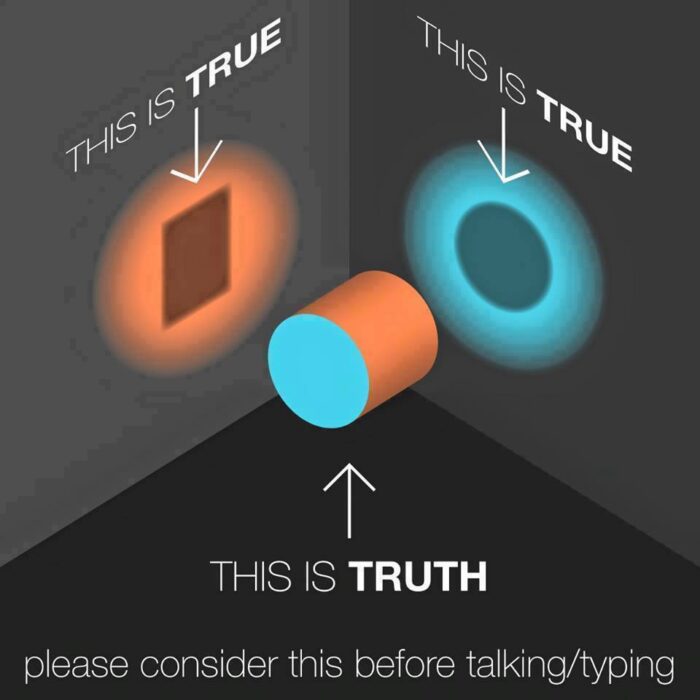Axis Mundi
“No tree… can grow to heaven unless its roots reach down to hell.” Carl Gustav Jung
05 June, 2020Ayami (Shaman figure), Nanai People, East Siberia
This shaman figure, made of bone, is depicted wearing a hat with seven heads, presumably representing ancestors, historically important clan members or wise men. The heads are the shaman’s helper spirits or guides in the world underpinning the world of the living; the world before it’s tangible to our senses. The spirit helpers provide the shaman with multiple perspectives which is the essence of wisdom, the stock-in-trade of shamans. The triangular shaped head, pointing down and perfectly balanced on the torso, implies an open mind with no predilections. The figure has a disproportionally large head (40% of its entire body while man naturally is 14%), implying that, unlike others who use their physical body when working, the head plays an outsized role in the shaman’s work.
Moreover, the figure is sexless as, unlike most work in tribal societies which is exclusively the domain of one sex or the other, a shaman can be male or female. As well, without sexual identity, the shaman’s perspective is unbiased, nondual.
11 October, 2020Bactrian Silver Trumpet, Late 3rd – Early 2nd Millennium BC
At first sight, this object engaged my attention; great presence (which has not diminished with time), surreal, and enigmatic as it seemed to have an ambiguous utility function. Initially, I thought it was a hearing aid; the top inserted in the ear and the bottom the mouthpiece. Others have guessed it a spout for pouring wine or an implement used for snuffing out a candle. However, notwithstanding other creative uses, it’s a mini trumpet a shepherd would use to get the attention of another shepherd in the distance.
Now, I see it metaphorically; a mouthpiece through which the breath of God enters a human head which processes the breath into sounds. The sounds are music. The sounds are signals, like words. An apt description of this blog as I, your humble writer, am just here to convert the breath of God into words for all to hear.
07 March, 2023Black Hole/Big Bang
Joshua Henderson
Josh was a friend, an artist, a father, husband, handsome, a lot of fun and endless other characteristics. Josh was also bipolar; at times a big bang, at times a black hole. Ultimately, the black hole turned into a big bang; Josh used a rifle to end his days.
10 July, 2019Container, Djibouti
This contemporary, post-WWII, object describes the evolution of society from tribal peoples to the modern world. The social evolution is marked by the change from a group-centered to an individual-centered world. The base of the container represents the foundation of civilization, tribal peoples. The tribe members are connected as one in dance. The faces of the dancers are undifferentiated and their bodies unclothed, implying their essential selves. Each member is not an individual; they are the dance. As societies evolved, they centered around the head, the mind. The members’ heads surround the container, the mind, and are differentiated by facial expressions and hairstyles. At the top, the container’s lid, is a man sitting alone in contemplation, lost in thought. The man, now individual-centered, closes the container/mind and no longer connects to others as in the dance.
24 October, 2020Eye idol, 3700 – 3500 B.C., Tell Brak, Levant
This 5500 year old female figure comes from the time before the dawn of the written word. Much has changed since then but perhaps men have not. The figure is depicted with eyes, nose, breasts and a vagina; but no mouth or ears. Perhaps that’s how most men like their women.
More seriously, what this apparently sacred object (it is referred to as an “idol”) means is open to interpretation. Eye idols are almost invariably depicted with eyes only; no mouth, nose or other body parts. Perhaps that’s the nature of a presumably all-knowing deity, they observe and do not speak. As Lao Tzu observed more than 3000 years later: “He who speaks does not know, he who knows does not speak.”
27 April, 2022Eye Idol, circa 3700 – 3500 B.C., Tell Brak, Levant
Thousands of these presumably votive “Eye Idols” have been found in a building now called the Eye Temple in Tell Brak. They depict a deity who observes the world but lacking ears and a mouth does not hear or speak. The deity’s view is pure, unadulterated by the words of others which could have the deity see the world as they would wish the deity to see it. Lacking a mouth, the deity knows but does not speak; implying that those who speak do not know and those who know do not speak. In the contemporary world, seeking enlightenment, some monks take a vow of silence.
To view other eye idols, click here.
16 October, 2020Fujiyama
Kanako Iiyama
In the Edo Period some believed that Fujiyama was a female deity and that by climbing the mountain one would be reborn, purified and able to find happiness. Today, most people are made happy by the mountain’s simple beauty.
The pantheist star (on the waters below, reflecting the top of the mountain and the sun rising) informs us that everything we see is only one thing: energy in its infinite manifestations.
07 February, 2021- 23 August, 2020
Iberian Idol, 3rd Millennium B.C.
As an abstract, non-representational, cylindrical sculpture, this artwork is referred to as an”idol.” Its solar eye suggests the universe is revealed by the light emanating from the eyes of God.
02 October, 2022It Is What It Is Whatever It Is
Our mind is quicker than our eyes in defining what we see. It’s funny when our eyes prove our mind wrong. Unfortunately, we rarely open our eyes; otherwise, much of what our mind sees would be funny.
17 February, 2023- 14 December, 2023
Koan 81
The sun is always the same and all ways different.
20 November, 2024Kongo Fetish
This surreal 19th century Kongo fetish (an inanimate object worshiped for its supposed magical powers or because it is considered to be inhabited by a spirit) depicts a bundle containing juju (magical substances that empower an object) from which a mirror-faced head with a feather atop emerges. When we look at the mirrored face of the object, we see ourselves. This suggests we are the fetish and the fetish works its magic through us. The feather protruding from the head suggests the mind of the fetish connects it to the spirit world; that can take flight and see beyond the range of man.
13 September, 2022Kotodama 60
Before time begins, all is the NON.
Upon birth, the I of the self and the NON become the NOW.
With the I of the soul, the NOW is a WOW.
The I of the self is red, symbolizing emotions. We experience the now through a myriad of selfish emotions.
The I of the soul is yellow; light, the essence of everything.
The experience of the “non”, with the I of self and the I of the soul, is a “wow.”
07 January, 2024Moon Road
Kanako Iiyama
Before midnight, August 1st, 2020, Awaji Island, Japan.
Awaji was the first of a group of islands born from Izanagi, a creator deity in Japanese mythology.
02 August, 2020Mother Goddess, 7th millennium BC
The serenity of this mother goddess amulet from the dawn of civilization is reminiscent of certain sculptures of Buddha who arrived at the dawn of human consciousness.
09 October, 2022Mr. Many Heads
This surreal figure (wood and pigment, 21 cm) is from the Lega tribe of the Democratic Republic of the Congo. It is called “Sakimatwematwe” or “Mr. Many Heads who has seen an elephant on the other side of the river.” As an aphorism, to see the greatest animal in the jungle (which is not easily seen as it is on the other side of the river) requires wisdom, fairness and omniscience, characteristics of someone who can view things from the different perspectives of many heads.
This object is in the Tomkins Collection. The collection can be viewed at tomkinscollection.org.
25 September, 2019Pantheist Star
Three years ago I was in LA in a shop that sells clothing and accessories. There I found the pendant in the photo above. Store manager said he had found it at a flea market and that it was a “Navajo star.” While I’m not a jewellery kind of guy, the pendant was sufficiently engaging that I purchased it. Researching after, I couldn’t find a Navajo star like it or another similar star. But that was of no matter as I liked the pendant as it was, regardless of any associations or stories that often accompany artworks. In time the pendant revealed itself as a symbol of pantheism, the view that everything is a manifestation of God.
The pendant depicts two stars with a common center. The shorter star ends in points and the longer one ends in heads. The shorter star represents energy/light. The longer star represents matter. Energy and matter have a common center as they are equivalent (E=M*C*C). The common center is God; hence, a pantheist pendant
The heads at the endpoints of the longer star represent consciousness; five heads, five senses. The longer star also appears like a “spread eagle” cheerleader pose, a celebratory pose.
When we realize we are one with everything and one with God, we experience the world via our senses, not our mind. That’s something about which to celebrate.
I’ve made 25 copies of the pendant and give them out to friends who would wear them. Three years later, I still have 15. I suspect none would be left had I offered them for sale.
28 August, 2020Pindi, Democratic Republic of the Congo
This whimsical, unique, rare dancing figure is not an iconic example of African art but one that is both inventive and allegorical. (For additional images of this figure, click here.)
With its arms oversized and swaying and its legs bent, the figure is dancing. The arms are oversized as they would be in a slow shutter speed photo of a dancer in motion.
It is both male and female. But unlike hermaphrodite figures generally (which host breasts and a penis), this figure has a vagina, a male torso (no breasts) and an Adam’s apple. It is a man with female genitals, as in dancing celebrations in West Africa where males dress as females.
Unlike this dancing figure which is rare, the majority of tribal art figures are standing, not dancing, and host a head that is disproportionately large relative to torso. This figure has a tiny head and long neck separating the head and the torso. The message it conveys is that when we are dancing our experience is physical and our heads play a disproportionally smaller role in how we experience the world. A corollary is that when we are not physically engaged our experience is a function of our head.
23 October, 2020Siberian Shaman Amulet
This 5.9cm object is reputedly a charm used by a Siberian shaman. A shaman is a healer and diviner. The etymology of “shaman” is the Tungus root sā-, meaning “to know.”
At first blush it looks like a maskette with a smiling or angry human face, spanning the gamut of human emotions. The empty or negative space within the outline of the face is greater than the lines that form the facial features. That suggests that what’s behind the face, the mind, is empty. With our mind empty, we are cured from much of what ails us and are free to see beyond ourselves, the future.
Alternatively it looks like a woman’s body without a head; just a pair of breasts, vagina and protruding legs. For some men that would be the ideal woman as it would cure them of much of their woes.
20 December, 2021Slow Round 11 Watch
This one-hand quartz watch is an entertaining timepiece.
The watch’s one hand is gold-colored and emanates from a gold center disk, presumably the sun. The one hand is like a ray of sunlight whose movement reflects the passage of time. A full-circle move of the one hand represents the 24 hour day. Hence, the perimeter is crowded, allowing only markers that indicate time in quarter-hour segments. The day begins and ends at the lowest vertical point on the perimeter, the darkest hours. Other than the one hand and the markers, the watch face is a dark blue cover over the watch’s internal movements which is like dark matter; unseen but presumed to affect all that is seen.
With one-hand indicating time, it is like a sundial. Like the movement of the sun’s golden rays is the movement of the watch’s gold-colored hand. However, sundials are the most primitive of time-telling machines and this watch, propelled by a quartz movement, is most modern.
With a quartz movement, the watch accurately measures time with a monthly accuracy of 15 seconds, considerably more accurate than a mechanical watch. However, as it has no markers indicating minutes, reading the time indicated is a bit of guesswork with 5 minutes leeway. Ironically, the most accurate watch is also the least accurate watch.
As reading the time indicated is a bit of guesswork, this watch is unlike mechanical watches which we read without thought. Reading time on this watch requires our attention, awakening us a bit, and each reading is like never before which is the nature of time. Moreover, as we cannot precisely read the time, we know we can never be completely certain where we are in time. Maybe we can’t be certain of other things as well. If so, best to go slow and not make choices impetuously. As well, we are unlikely in the same time-place as most other people whose watches are more in sync.
The preceding is what I see in this watch, making the watch funny. Funny in that the watch allows very different views which are at odds. In looking at things I always find something about them funny. If not, I know I don’t know what I’m looking at.
17 December, 2021Soul
Image of the soul created by artificial intelligence.
The image suggests the soul is like a sun that our body shrouds in darkness. The soul represents love as it resides as does our heart in the center of our upper body. In the stillness of meditation, we realize our soul is but one of an infinite number of eternal stars (a universe of infinite centers) and our body (the personal self) is nothing but empty space.
18 February, 2023Taisha
Takeshi Fuji, photographer
Shiga, Japan, 2/2/2022
There are 8 million gods recognized in the Shinto religion in Japan, a number that in traditional Japanese culture is considered synonymous with infinity. Taisha (coincidentally, pronounced like my name, Teicher), is the oldest and biggest shrine in Japan where it is said that all the gods meet annually. This photo, not of the Izumo Taisha Grand Shrine, is metaphorically Taisha. It depicts a reflecting light path over water (coincidentally, “teich” in German is “pond”) and through a shrine to the sun god, the origin of everything. The sun god is seen rising over mountains and through clouds. The mountains are opaque, ignorance, which requires great efforts to climb above. The clouds are translucent, our mind which otherwise is what shrouds the light that is everywhere.
24 February, 2022Tao
This symbol of Taoism reveals the essence of Taoism. Tao, in Chinese, literally means the (right) way. The Tao is the way, the nature, of reality; the way of the universe; and the harmonious way or path through life.
The circle represents the universe. Within the universe are two seemingly independent abstract fish forms, in shades black and white, that are actually interdependent as curled together they form the universe as a whole. The fish represent life, consciousness, which is what makes the universe whole.
Each fish has an eye, black or white, reflecting the shade of the other. Looking eye to eye, each sees its own shade in the other. Likewise, when we look in the eye of others, we see ourselves.
The way through the life, along the interface of the white and black forms, is everchanging; bending left and bending right; requiring us to be conscious of our way, lest get lost in the white or black forms.
Ultimately, the symbol of the Tao implies all things in the universe are interdependent; the path through life is everchanging; however, life is in balance, harmonious, when we consciously move between counterbalancing forms.
Another interpretation is the symbol represents two animals engaged in a sexual position commonly known as “69.” If so, the message there is that a happy way to make it through life is simply enjoy yourself.
As above, the Tao acknowledges there are different ways for different people.
26 April, 2023Tiki ivi po’o
This Marquesas Islands personal adornment is made of human bone and often worn as a necklace, hair braid or used as a fan handle. It represents a generic ancestor deity.
While the deity is in human form, the head is disproportionally large; implying the deity embodies far greater wisdom than humans. Likewise, its eyes are disproportionally large, implying the deity sees far more than mortals.
Perhaps the presence of such an ancestor deity in physical form as a personal adornment humbles its owner, reminding them there is more to this world than they are capable of knowing and seeing. Humbled, the owner will not suffer the consequences of hubris.
05 December, 2023Truth
What is true does not necessarily reveal the truth.
16 January, 2022

